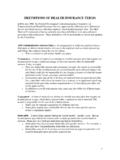Transcription of Health Savings Accounts (HSAs) Reporting Rules
1 This Compliance Overview is not intended to be exhaustive nor should any discussion or opinions be construed as legal advice. Readers should contact legal counsel for legal advice. EMPLOYER REQUIREMENTS Employers report their contributions to employees hsas using the Form W-2. Employers may deduct their HSA contributions on their business tax returns. Employers have no Reporting responsibilities relating to HSA distributions. HSA OWNER REQUIREMENTS HSA owners report distributions and contributions (regardless of the source) on Form 8889. Form 8889 must be filed as an attachment to Form 1040 (even if the HSA owner had no other reason to file the Form 1040). Health Savings Accounts ( hsas ) Reporting Rules A Health Savings account (HSA) is a trust or account used to pay medical expenses that a high deductible Health plan (HDHP) does not pay.
2 hsas offer triple tax advantages to account owners, including tax exemptions for contributions, earnings and distributions. Many employers offer HDHPs to control premium costs and pair the coverage with hsas to help employees cover their Health care expenses. The Internal Revenue Service (IRS) has stated that all contributions to hsas and distributions from hsas are reportable transactions for federal tax purposes. HSA owners and employers that contribute to hsas are both responsible for HSA Reporting . This Compliance Overview provides general HSA Reporting information for both employers and individuals. LINKS AND RESOURCES Individual Form W-2 for Reporting contributions made to each employee s HSA Small business and large business income tax returns for deducting employer contributions to employee hsas IRS Forms: Form 8928; Form 8889; Form 1040; Form 5498-SA; Form 5329; Form 1099-SA Provided by 360 Corporate Benefit Advisors 2 This Compliance Overview is not intended to be exhaustive nor should any discussion or opinions be construed as legal advice.
3 Readers should contact legal counsel for legal advice. 2016 Zywave, Inc. All rights reserved. CMP 9/16 EMPLOYER Reporting Contributions In general, when an employer makes contributions to employees hsas , the employer must report them on the individual Form W-2 for each employee that received a contribution. The amount an employer reports on Form W-2 must also include any money the employee elected to contribute to the HSA through a cafeteria plan. These HSA contributions are non-taxable wages that the employer must enter in Box 12 of Form W-2 along with the code letter W. In addition, the Affordable Care Act (ACA) requires employers to report the aggregate cost of employer-sponsored group Health plan coverage on their employee s Forms W-2, in Box 12, using code letters DD.
4 Currently, this Reporting requirement only applies to employers that file 250 or more Forms W-2. The ACA Reporting requirement does not apply to HSA contributions because these amounts are required to be separately accounted for on the Form W-2 (under Box 12 using code letter W). Employers may deduct their HSA contributions on their small business or large business income tax returns. For most employer contributions, the amounts are reportable as employer-provided coverage for medical expenses under an accident or Health plan. These amounts are not subject to employment taxes. Special Rules apply for HSA contributions made on behalf of certain individuals, such as sole proprietors, partners of partnerships, members of limited liability companies and individuals who own more than 2 percent of an S-corporation.
5 For example: Taxable Contributions If, at the time of payment, it is not reasonable to believe that an HSA contribution will be excludable from an employee s income, the contribution is subject to federal income tax withholding, Social Security and Medicare taxes and federal unemployment taxes. A contributing employer must report these contributions in Boxes 1, 3 and 5 of the employee s Form W-2 and on the employer s Form 940. The employee, and not the employer, is primarily responsible for determining eligibility for HSA contributions. IRS Notice 2004-50 states that an employer is only responsible for determining whether the employee is covered under an HDHP or any low-deductible Health plan sponsored by the employer, including Health FSAs and HRAs.
6 3 This Compliance Overview is not intended to be exhaustive nor should any discussion or opinions be construed as legal advice. Readers should contact legal counsel for legal advice. 2016 Zywave, Inc. All rights reserved. CMP 9/16 Contributions made by: To the HSA of: Are treated as: A partnership A partner Distributions of money, which are: Not deductible by the partnership; and Not included in the partner s net earnings from self-employment. A partner, as compensation for services rendered Guaranteed payments, which are: Deductible by the partnership or S-corporation (if certain requirements are satisfied); and Included in the partner or 2-percent employee-shareholder s gross income. An S-corporation A 2-percent employee-shareholder, as compensation for services rendered *Distributions of money and guaranteed payments are reported on Schedule K-1 of Form 1065.
7 For any calendar year, the deadline for making contributions to an employee s HSA is the date on which the employee s income tax return for that year is due. For example, contributions for 2016 may be made until April 17, 2017. If an employer makes a contribution on or after Jan. 1 of the year subsequent to the year to which the contribution is allocated (for example, a contribution for 2016 made on Jan. 2, 2017), the employer must: Notify the employee and the HSA trustee that the contribution is for the previous year; Deduct the contribution amount in the year in which the contribution was made (even though it was allocated to the previous year); and Report the contribution amount on the employee s Form W-2 for the year in which the contribution was made (even though it was allocated to the previous year).
8 Finally, employers that make HSA contributions outside of a cafeteria plan are required to make comparable contributions to the hsas of all comparable participating employees. If an employer made contributions to an employee s HSA that did not meet comparability requirements, the employer may have to pay an excise tax of 35 percent of the amount contributed in violation of the Rules . These excise taxes are reportable on Form 8928. Distributions Because employers have no involvement in how HSA owners spend HSA funds, they do not have any HSA Reporting responsibilities relating to HSA distributions. HSA OWNER Reporting HSA owners must report all HSA distributions and contributions (regardless of the source) on Form 8889 and file this form with the IRS as an attachment to Form 1040.
9 The attachment requirement applies if 4 This Compliance Overview is not intended to be exhaustive nor should any discussion or opinions be construed as legal advice. Readers should contact legal counsel for legal advice. 2016 Zywave, Inc. All rights reserved. CMP 9/16 there were any distributions from an HSA even if the HSA owner had no taxable income or any other reason for filing a Form 1040. Contributions HSA owners must report any HSA contributions that were made by employers (including any amount the employee elected to contribute through a cafeteria plan) on Line 9 of Form 8889. This should match the amount reported by the employer in Box 12 of the W-2. All other contributions (except amounts rolled over to the HSA from other specific Accounts ) must be reported on Line 2 of Form 8889.
10 An HSA owner should receive a copy of Form 5498-SA from the HSA administrator showing the total contributions made to the HSA. HSA contributions are subject to annual maximums depending on the type of HDHP coverage the HSA owner has. Any amount above these limits may be taxable as income and subject to a 6 percent penalty. Excess contribution taxes and penalties can be calculated using Part VII of Form 5329. If the contribution limits were not exceeded, the HSA owner may be able to deduct his or her contributions that were entered on Line 2 of Form 8889 from his or her taxable income. The HSA owner must enter the amount for this deduction on Line 25 of Form 1040. Distributions When distributions were made from an HSA, the account administrator must report them to the IRS on Form 1099-SA and provide a copy to the HSA owner.





